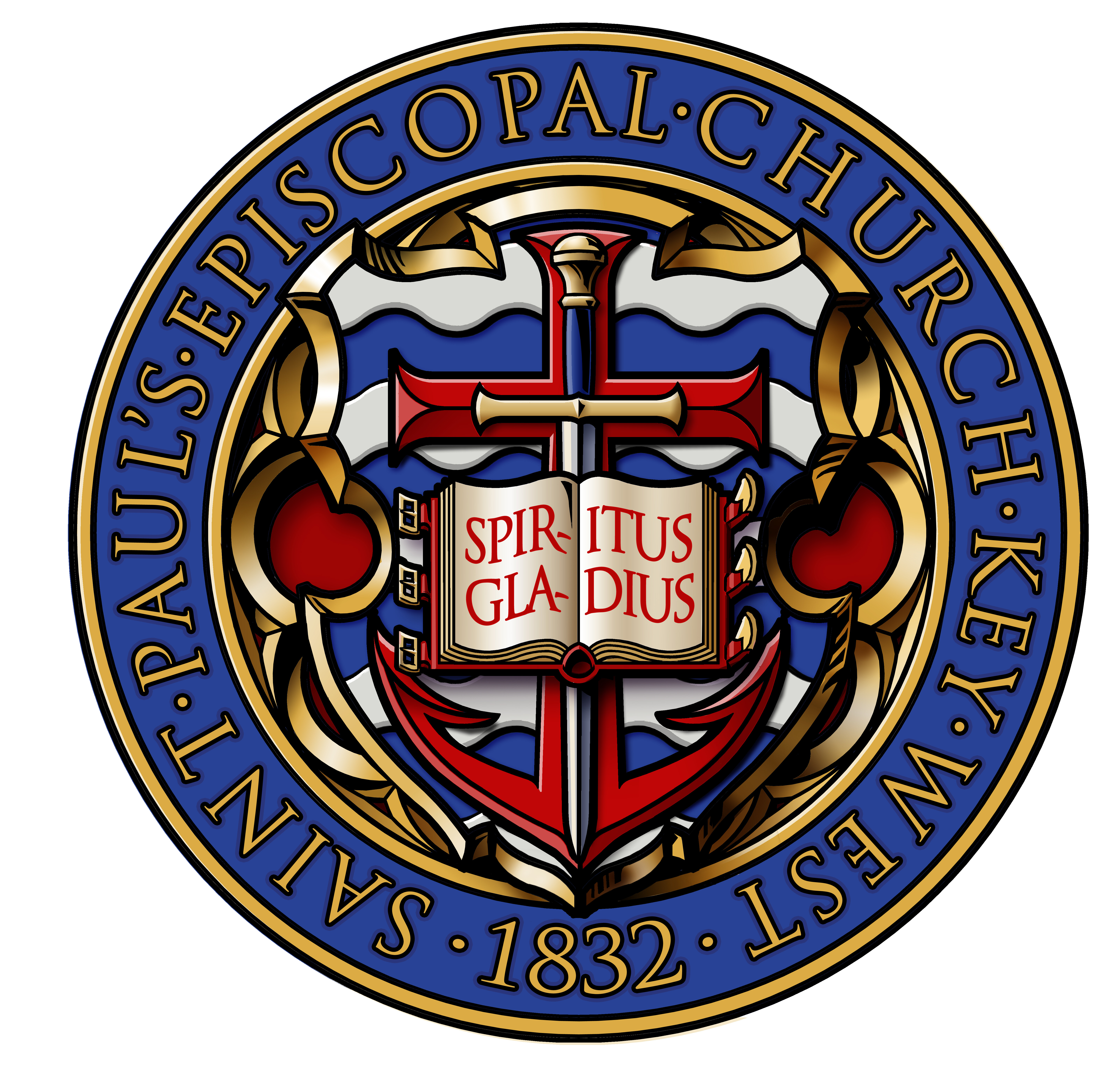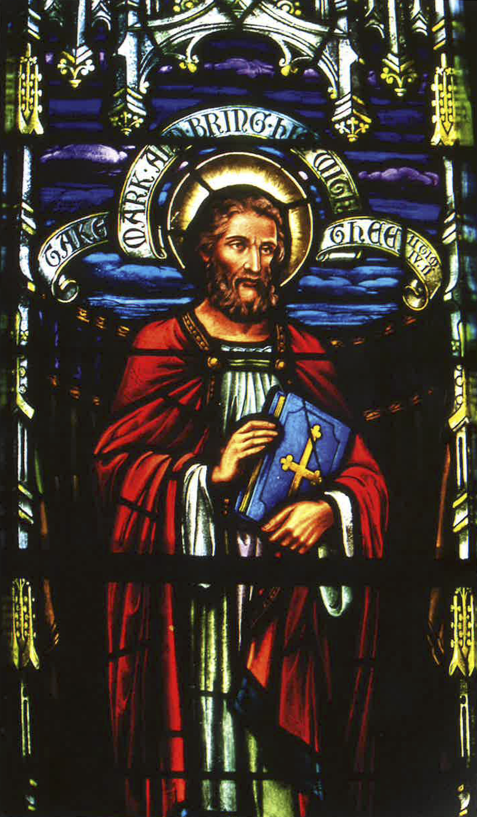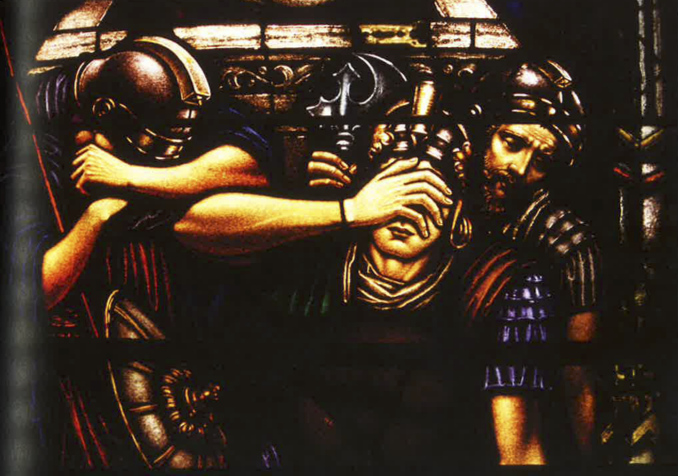The Glass Studios
The 12th and 13th centuries in Europe were termed the "Golden Age of Glass," as the Gothic age produced the great cathedrals of Europe and brought a full flowering of stained glass windows. Medieval churches with their translucent pictures of biblical stories and saints lives made them a sacred dwelling place of an all powerful God.
The Renaissance, however, with its focus on painters, brought the art of stained glass into a 300 year period where windows were heavily painted white glass, with lead lines becoming decorative elements only. As a result of this painterly trend, during the 18th century many of the medieval stained glass windows were removed and replaced by painted glass. Thus the art of colored glass faceted with lead all but died until the late 1800s when glass studios in England once again became prominent.
The Bolton Brothers, English immigrants, established the first stained glass studios in America. At the turn of the 20th century, the revival of the traditional art of stained glass swept America and new designs and techniques were introduced by American glass artists such as Louis Comfort Tiffany, George Hardy Payne, Richard Spiers, Wilbur Burnham, and others.
The stained glass windows in St. Paul's Episcopal Church in Key West represent over 80 years of American stained glass. The remoteness the island did not for a moment deter the parishioners of St. Paul's from commissioning some of America's most recognized stained glass studios for the work in their church. Well-known national firms such as Phipps, Ball & Burnham, Payne Spiers and Charles Connick Associates, whose works grace such major churches as the National Cathedral in Washington and the Cathedral of St. John the Divine in New York City, were contracted to bring their work to Key West.
That these island parishioners were aware of the stained glass movement in the United States and chose the very best in the nation for the glass work in their church, is a tribute to their worldliness. Although in a remote location, the islanders were by no means isolated and unsophisticated. Sailing ships from al over the world passed through the strategic port of Key West, long known as the "Gibraltar of the Caribbean." Many Key West residents were involved in some aspect of the lucrative shipping trade and traveled al over the world, acquiring fine artistic tastes from the far reaches of the globe. Some passengers and crew aboard the many sailing vessels traveling the shipping lanes of the Gulf Stream, who stopped at the busy seaport of Key West, decided to stay, bringing with them ideas and tastes from their former homes. Yet another source of global influence on Key West was its strong business and familial ties with Havana, an elegant old world Spanish city.
Today the doors of St. Paul's Church are open daily for al those who wish to enter for prayer and meditation, or simply to experience its beauty. Unfortunately for passersby, the beauty of the stained glass windows cannot be appreciated from the outside as they are protected from damage by a strong, translucent plastic material placed over the window exterior. While offering some degree of protection from wind-driven objects and hurricane force winds, this covering has yellowed with age, effectively obscuring the images from the outside. There is currently an effort underway to secure funds to protect these priceless windows with new hurricane-rated clear glass. This improvement would not only provide optimum protection, but would also allow the glorious windows to be appreciated both inside and out.
[N.B.: Winifred published these words in 2007, but in 2024, the yellowed plastic is still in use. Upgrading these coverings is a restoration priority for St. Paul's current capital campaign. To donate, click the button at the bottom of the post and select "Capital Campaign" from the drop-down menu.]
Stained Glass Studios represented in the windows of St. Paul's Church
Phipps, Ball & Burnham (1920)
Payne Spiers Studio (1940)
Charles Connick Associates (1950)
Harry Taylor (1970)
Powell Brothers & Sons Glass Art (1999-2005)
PHIPPS, BALL & BURNHAM
Over one-half of the stained glass windows in St. Paul's Church were designed and installed by Phipps, Ball & Burnham in the 1920s, immediately following the construction of the church.
The studio is responsible for all windows featuring roundels, circular themed panels, each depicting a different "Sign of Our Faith." These windows are long and rectangular, centered by an embellished cross with a roundel placed where the arms intersect, set against a background of opalescent glass. Each roundel contains a different religious symbol. A series of roundel windows along the lower level of the nave and in the north and south transept, open for ventilation. Roundels are also featured in the stationary south tower and bell tower clerestory windows.
Phipps, Ball and Burnham is also responsible for the major narrative windows positioned in the four compass corners of the cruciform church. On the east end, in the chancel over the High Altar is Crucifixion (Window #117); Nativity Adoration (Window #112) is in the south transept clerestory; Ascension/Pentecost/Resurrection (Window #122) is on the opposing wall, in the north transept clerestory; and Christ's genealogy, depicted in Jesse Tree (Window #102) is in the clerestory over the Baptistry at the west end of the church.
Two narrower Phipps, Ball & Burnham windows, appropriately occupying a place of honor on either side of Crucifixion over the high altar, feature St. Paul, for whom the church is named. The choice of the Apostle Paul as the patron saint of the church undoubtedly came from the connectivity between one of the stories of Paul the Evangelist and the history of Key West. As told in Acts 27, 28, Saint Paul survived both a hurricane lasting fourteen days and a subsequent shipwreck.
When these first windows were initially commissioned, Phipps, Ball & Burnham was called Ball & Burnham. In the vestry minutes of S.t Paul's ti is recorded that Mr. Ball was in Key West on July 14, 1919, and having already in hand a number of contracts for these memorials, he submitted a proposition to furnish cathedral glass windows for the lower openings and tower for about $1,300. At that meeting the vestry signed a new agreement for placing the Sunday School window in the chancel. According to St. Paul's history, the actual window installation began in 1920. By this time the firm's name had changed to Phipps, Ball & Burnham; by 1922 it was in the name of Burnham alone.
Wilbur Herbert Burnham was born in Boston on February 4, 1887, the son of Wilbur Leroy and Mary (Oxley) Burnham. He was educated at East Boston High School and studied at Massachusetts School of Art from 1904-08. He also studied stained glass in France, England, Italy and Spain.
He began his career as a designer of stained glass for Harry Goodhue in Boston, woking there from 1906-1916. He worked for Horace J. Phipps Company of Boston from 1916-18; from 1918-1920, he was in business with Ball and Burnham. The firm then became Phipps, Ball and Burnham until it was dissolved in 1922, leaving only Burnham at the helm.
Burnham, along with Charles J. Connick and Joseph G. Reynolds, comprised a triumvirate of nationally prominent glass designers in Boston. Some of Burnham's stained glass efforts are represented in the Cathedral of St. John the Divine (10 windows), the Washington National Cathedral, Riverside Church in New York City, and Rollins College in Winter Park, Florida.
Wilbur Herbert Burnham, artist and designer of stained glass windows, died at Melrose-Wakefield Hospital in his 87th year.
Of Burnham's thirty-seven windows in St. Paul's Church, Bob Jones of the Stained Glass Association of America noted in a letter dated July 13, 1995:
Burnham was held in such esteem, and [St. Paul's] is a, if not the, most important assemblage of his early work.
PAYNE SPIERS
Richard Spiers was one of the leading stained glass artists of the American revival of the traditional art of stained glass during the early 20th century, while George Payne was a well-known glass maker whose business dated back to 1875. Spiers' son, George, joined forces in 1935 with George Leslie Payne, grandson of the George Payne, to create Payne Spiers, located in Patterson, New Jersey. The two worked together from 1935 until 1946, and were responsible for numerous magnificent stained
glass windows in many churches throughout America in the 1940s.
In St. Paul's Church, the Payne Spiers studio created Wedding Feast at Cana (Window #109) and Feeding of the Five-Thousand (Window #107), both in the south nave clerestory. These magnificent narrative windows depict two of the miracles of Jesus.
Payne Spiers is also responsible for the incredibly beautiful and intricate wood reredos behind the High Altar, donated by George and Julia Johnson, Hiram and Leonora Seymour, Lillian Louisa Bartlum, Nellie Isabelle Curry, and John and Eliza Pitcher.
CHARLES J. CONNICK ASSOCIATES
Four windows in St. Paul's Church were designed by Charles J. Connick Associates, another major American glass studio: Christ Among the Doctors (Window #108) in the south nave clerestory; Transfiguration (Window #127) in the north nave clerestory; and the two prophesy windows, Genealogy Window - Prophets (Window #101 and #103), flanking Phipps, Ball & Burnhams' Jesse Tree to create the great west window in the clerestory above the Baptistery.
Although Charles J. Connick died in 1945, before the windows were installed, the studio continued under the direction of the very able Orin E. Skinner. In an article in the Quarterly of the Stained Glass Association of America (Volume 88, Number 2, Summer 1993), from 1920 until his death Charles Connick counted on his "left-handed, right hand man," Orin Skinner, to get the job done. Connick was the spark plug of the studio and liberally delegated the daily responsibilities to his assistants. Orin Skinner handled the art, production, scheduling, personnel, sales and installation. Elizabeth Bruder ran the front office, scheduled appointments, kept the books and paid the bills. With this system, Charles J. Connick became the most influential and successful proponent of stained glass in America and was considered the leading American expert in his day in the stained glass field.
With the death of Connick, the studio continued to operate under his name. With Skinner as presi- dent and Mrs. Bruder ni the front office, the studio maintained the high quality for which ti was known. Skinner said that when Connick died, he had an awful time trying to convince people that the business would continue. He succeeded, and the studio continued for 41 years under his direc- tion with no shortcuts to the perfection or craftsmanship.
From the opening of the studio in Boston in 1913 until ti closed in 1986, the artists in the Connick studio led the American revival of the medieval style of the stained glass craft through their use of intense color and strong linear design. Windows created by the Connick studio can be found ni approximately 5,000 churches and public buildings around the world. When the studio closed, ti gave its collection of records and working drawings to the Boston Public Library.
Harry Taylor
Harry Taylor is the only local stained glass artist whose work is represented in St. Paul's. Little is known about Harry Taylor except for an article that appeared in the Miami Herald on July 14, 1968. The article states that Harry was from the Midwest, was 57 years old and was employed at Speas Glass Company in Key West.
Although Taylor worked in the field of ornamental glass all his life, he did not practice it in Key West until 1963. He was contacted by the church in 1968 to repair Nativity Adoration (Window #112). At a later date, at age 84, he was commissioned to create Christ with the Elders (Window #110) ni the south transept and Christ with the Fishermen (Window #124) in the north transept.
POWELL BROTHERS & SONS GLASS ART
Powell Brothers & Sons Glass Art is a family business in Salt Lake City, Utah which has been creating works of glass art for more than 30 years. Specializing in traditional stained and painted glass, they create artworks for settings around the world. Trained in glasswork by American and European instructors, the Powells have designed many works to be integrated into existing structures.
The lead Powell Brothers artists of their four chancel windows: Zacchaeus Climbing the Sycamore Tree (Window #119); Deborah and a Scroll Under the Palms (Window #115); Saint Barnabas (Window #114); and Miriam (Window #120) were Jenkyn A. Powell and his son, J. Elijah Powell. Powell Brothers also designed and installed the four windows inside the choir room and two in the sacristy. The latter windows are not visible from the sanctuary.
The Powell Studio is recognized as one of America's leading glass studios and has affiliations with the International Guild of Glass Artists. It is a member of the AlA Interfaith Forum on Religion, Art and Architecture, and is an Accredited Full Service Studio Member of the Stained Glass Association of America.
UNKNOWN STUDIOS
For 10 windows there has been no record found to date of the artist, the studio or the installer. Therefore no credit can be given. It is possible that Holy Trinity/Te Deum (Window #125), attributable to Phipps, Ball & Burnham, was made by F.X. Zetler of Munich. However, there is no documentation to confirm that speculation.
Source: The Golden Cockerel: The Art, Symbolism & History of the Stained Glass Windows, St. Paul's Episcopal Church, Key West, Florida by Winifred Shine Fryzel.
Please consider making a donation to St. Paul's so that we may continue our work, including the stewardship of our beautiful grounds, buildings, and windows.




Login To Leave Comment